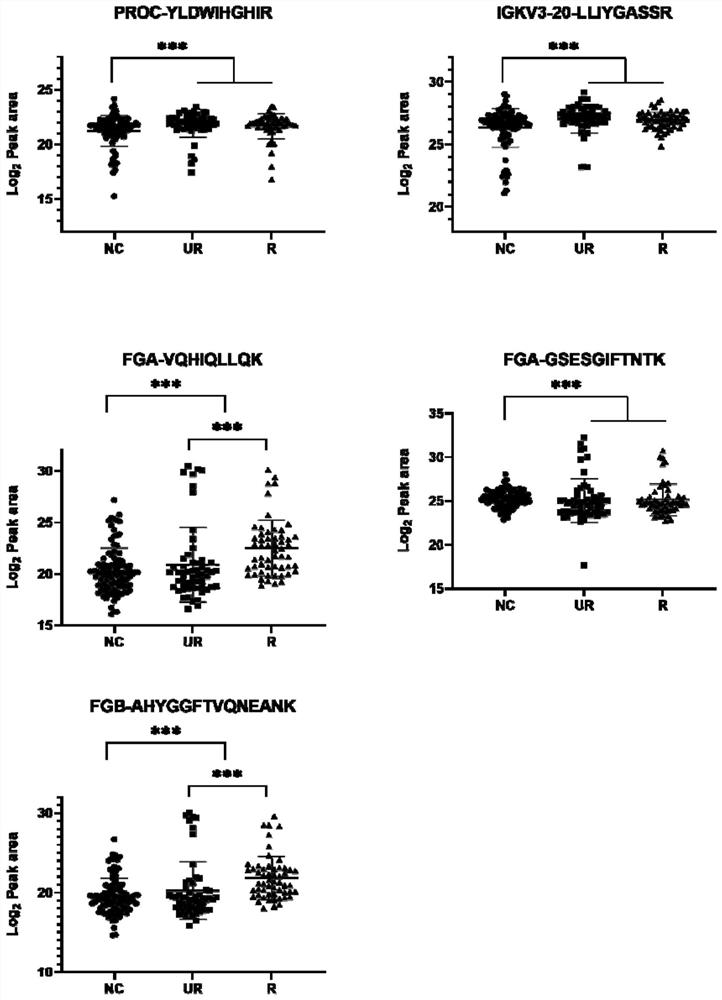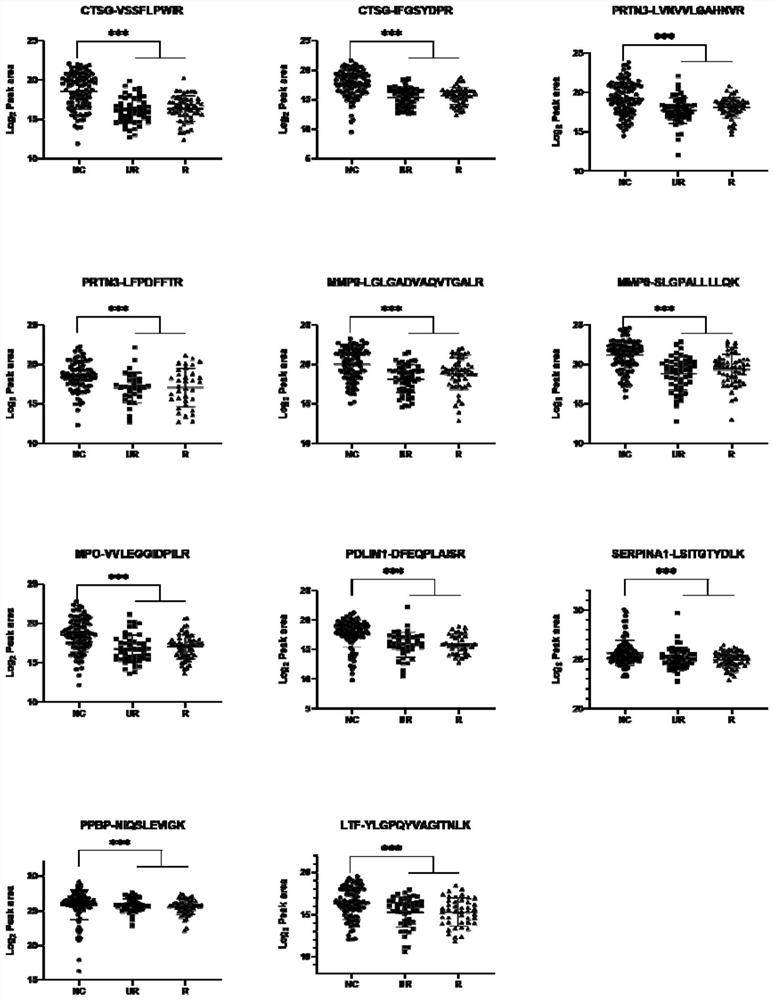Serum marker for diagnosing intracranial aneurysm and serum marker for predicting rupture potential of intracranial aneurysm
A technique for intracranial aneurysm and serum markers, which is applied in the field of medicine and biology to achieve the effects of reducing inspection costs and high sensitivity
- Summary
- Abstract
- Description
- Claims
- Application Information
AI Technical Summary
Problems solved by technology
Method used
Image
Examples
Embodiment 1
[0112] Collection and preparation of 212 cases of ruptured intracranial aneurysm / unruptured intracranial aneurysm serum and normal human serum
[0113] Randomly grouped according to gender and age, 100 healthy people (NC) were collected as controls, 57 patients with unruptured intracranial aneurysm (UR), and 55 patients with ruptured intracranial aneurysm (R).
[0114] Main instruments and reagents: blood collection tubes, centrifuge tubes, BCA quantitative kit (Thermo Fisher Scientific, USA), peptide quantitative kit (Thermo Fisher Scientific, USA), tetraethylammonium bromide, DTT, IAA, trypsin, etc. .
[0115] Experimental steps:
[0116] 1. Collect serum samples:
[0117] (1) Collect whole blood into vacuum blood collection tubes, gently mix up and down for 5-6 times;
[0118] (2) Place at 4°C for 30-45 minutes;
[0119] (3) Centrifuge at 1000g for 10min at 4°C (after centrifugation, the upper layer of serum, the middle gel, and the lower layer of blood cells);
[0120...
Embodiment 2
[0129] Targeted proteomic validation of serum markers of ruptured / unruptured intracranial aneurysms
[0130] The expression levels of 20 candidate protein factors (25 peptide factors) in 212 serum samples were determined by PRM mass spectrometry.
[0131]Main instrument: Orbitrap Exploris 480Mass Spectrometer (Thermo Fisher Scientific, USA)
[0132] Experimental procedures: Chromatographic column model: 50cm C18 chromatographic separation column (2μm, 75μm, x 500mm, Thermo Fisher Scientific, USA); flow rate: 200nL; gradient: phase A: 0.1% FA aqueous solution; phase B: 80% ACN. Separation gradient 0-50% phase B, total separation time: 65min; Orbitrap Exploris 480 mass spectrometry parameters: use PRM mode for collection. Primary scan range (m / z): 350-1600; import the mass-to-charge ratio and retention time information (Table 1) of the target peptide into the designated list.
Embodiment 3
[0134] PRM data collection and bioinformatics analysis
[0135] Import the original data into Skyline-Daily software for data collection: (1) import the Fasta file of the target protein into skyline; (2) peptide setting: the background library is the Uniprot library, and the search result file is imported as the spectral library, and the peptide length is 8-25AA; (3) Product ion (Transition) extraction settings: parent ion charge: 2; select the strongest product ion for extraction according to the spectral library; the acquisition mode is Targeted; 25 peptides selected by 20 candidate protein factors The parent and child ion information of the segment is shown in Table 2. (4) Manually check the extraction time of each product ion and the first-level ID time, and compare the retention time, peak area, etc.; (5) Export the peptide ratio results for subsequent statistical analysis.
[0136] The exported data were statistically analyzed with SPSS Statistics 20 software: Mann-Whit...
PUM
 Login to View More
Login to View More Abstract
Description
Claims
Application Information
 Login to View More
Login to View More - R&D
- Intellectual Property
- Life Sciences
- Materials
- Tech Scout
- Unparalleled Data Quality
- Higher Quality Content
- 60% Fewer Hallucinations
Browse by: Latest US Patents, China's latest patents, Technical Efficacy Thesaurus, Application Domain, Technology Topic, Popular Technical Reports.
© 2025 PatSnap. All rights reserved.Legal|Privacy policy|Modern Slavery Act Transparency Statement|Sitemap|About US| Contact US: help@patsnap.com



